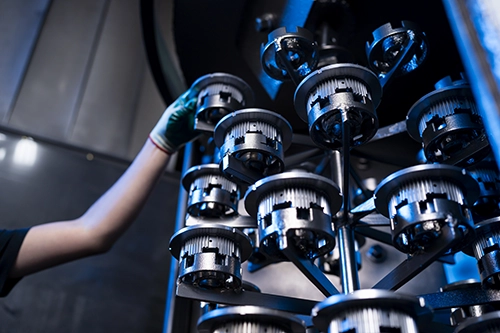At Vibra Finish Ltd., we take pride in offering high-quality surface finishing solutions, and glass bead blasting is one of the most effective techniques for achieving smooth, clean, and visually appealing surfaces. This guide will provide an in-depth look at glass bead blasting, from its process to its many applications, benefits, and best practices.
What is Glass Bead Blasting?
Definition and Overview
Glass bead blasting is a non-abrasive surface finishing process where spherical glass beads are shot at high pressure onto a surface. The technique is commonly used to clean, polish, and prepare surfaces without damaging the material underneath. Unlike other abrasive methods, glass bead blasting leaves behind a smooth, uniform finish, making it ideal for industries where aesthetics and surface integrity are key.

This method is widely used across industries such as automotive, aerospace, and general manufacturing, where it plays a crucial role in removing contaminants like rust, old paint, and debris, while ensuring the base material remains undamaged.
History and Evolution of Glass Bead Blasting
Glass bead blasting has come a long way since its introduction. Early methods of sandblasting were highly abrasive, which often led to material damage. However, the development of glass bead media offered a less aggressive yet equally effective solution. Over time, advancements in equipment, such as modern blasting cabinets and nozzles, have made glass blasting more precise and efficient, enabling it to be used in more delicate and high-precision industries like aerospace and medical manufacturing.
How Glass Bead Blasting Works
The Blasting Process in Detail
The glass bead blasting process involves several key steps:
- The surface to be treated is cleaned and prepped.
- Glass beads for blasting are loaded into a blasting machine.
- Compressed air propels the beads through a nozzle, directed at the target surface.
- The beads impact the surface, gently removing impurities without altering the material’s dimensions.
Key considerations during this process include choosing the right bead size, air pressure, and maintaining a consistent blasting distance to ensure an even finish.
Equipment and Tools for Glass Bead Blasting
Successful glass bead blasting requires specialized equipment, including:
- Blasting cabinets to contain the media.
- Nozzles of varying sizes for different applications.
- Air compressors to generate the high pressure needed for blasting.
Maintaining equipment is essential for achieving the best results, as worn nozzles or inconsistent air pressure can affect the quality of the finish. Choosing the right tools and regularly servicing them ensures maximum efficiency and performance.
Benefits of Glass Bead Blasting
Surface Finish and Aesthetic Improvements
Glass bead blasting is highly valued for its ability to create smooth, satin, or matte finishes. This is particularly important for applications where appearance and texture matter, such as automotive parts or decorative metals. It not only improves the look of the material but also enhances its ability to bond with coatings, paints, or adhesives.
Non-Abrasive and Environmentally Friendly Solution
One of the primary advantages of glass bead blasting is that it’s a non-abrasive technique, making it safe for surfaces like aluminum and stainless steel, where preserving the material’s integrity is essential. Additionally, glass bead media is environmentally friendly. The beads are made from recycled glass and can be reused multiple times, making them a sustainable option compared to other blasting materials.
Common Applications of Glass Bead Blasting
Automotive Industry
In the automotive world, bead blasting is commonly used for restoring vintage car parts, cleaning engine components, and preparing metal surfaces for painting or powder coating. The process ensures a smooth, rust-free surface without damaging the metal, making it ideal for sensitive automotive restoration projects.
Aerospace Industry
In the aerospace industry, glass bead blasting is used to clean and prepare parts, ensuring that components are free from debris and ready for assembly or coating. This technique is valued for its precision and non-damaging nature, which is critical in aerospace applications where material integrity is paramount.
General Manufacturing and Maintenance
From metal fabrication to machinery maintenance, glass bead blasting is widely used to clean, deburr, and prepare surfaces for further processing. The technique is effective for removing contaminants like scale and rust while preserving the material’s surface properties.
Glass Bead Blasting vs. Other Blasting Methods
Glass Bead Blasting vs. Sandblasting
Compared to traditional sandblasting, glass bead blasting is less aggressive, offering a gentler option for delicate surfaces. Sandblasting can wear away material over time, making it unsuitable for projects where maintaining surface integrity is important. Glass blasting is often preferred for jobs requiring both cleaning and preservation.
Glass Bead Blasting Media: Choosing the Right Type
How to Choose the Best Glass Beads for Your Project
Selecting the right type of glass bead media depends on the application. Factors like bead size, hardness, and the desired finish all play a role in choosing the appropriate media. Larger beads provide a more aggressive finish, while smaller beads result in a smoother surface.
Pros and Cons of Glass Bead Blasting
Key Benefits
- Non-abrasive: Preserves surface integrity.
- Reusable: Cost-efficient and eco-friendly.
Drawbacks and Limitations
While glass beading is effective, it may not be the best option for every project. For example, it’s not as effective at removing thick coatings or heavily rusted materials as more abrasive media.
Safety Considerations in Glass Bead Blasting
Protective Gear and Safety Procedures
Operators should always use appropriate protective gear, such as gloves, masks, and eye protection, to prevent injury during the glass blasting process. Proper ventilation is also necessary to avoid inhalation of dust or particles.
Environmental and Health Impacts
Glass bead blasting is relatively safe and eco-friendly, but proper disposal of spent media is important to minimize environmental impacts. Using recycled beads and ensuring minimal dust emission are key steps toward an eco-conscious blasting operation.
Conclusion
Glass bead blasting offers a versatile, safe, and eco-friendly solution for surface preparation, cleaning, and polishing across a wide range of industries. Its ability to deliver smooth finishes without damaging materials makes it the go-to option for many precision applications.
Frequently Asked Questions
Can Glass Bead Blasting Be Used on All Metals?
Yes, glass bead blasting is suitable for most metals, including aluminum, steel, and stainless steel.
What’s the Difference Between Glass Bead Blasting and Soda Blasting?
Glass bead blasting is more versatile and effective for a wider range of applications, while soda blasting is gentler, often used for softer surfaces.
Can Glass Bead Blasting Remove Rust and Paint?
Yes, glass bead blasting effectively removes rust, paint and mill scale without damaging the base material. For more information on glass bead blasting services, contact Vibra Finish Ltd. today!













